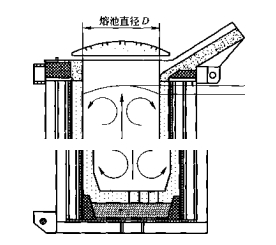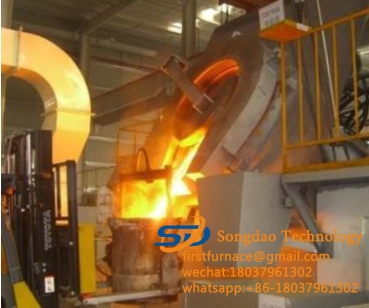- 29
- Jul
The top of the molten pool of the induction melting furnace forms a “hump” working principle
- 29
- 7月
- 29
- 7月
The top of the molten pool of the 誘導溶解炉 forms a “hump” working principle
In the smelting process of the induction melting furnace, once the metal material is melted, the melt will form a regular movement under the action of electromagnetic force. This movement starts from the center of the molten pool and moves to both ends of the coil. Because the metal is constrained by the furnace bottom and the furnace wall, the final movement is always upward, forming a “hump” at the top of the molten pool. Some data use the ratio of the height of the hump to the diameter of the molten pool to express the stirring strength of the molten pool. The appearance of the “hump” is shown in Figure 2-9.

Figure 2-9 Schematic diagram of the “hump” morphology of the melt in the induction melting furnace
ただし、誘導溶融炉の「こぶ」の形状を正確に表現し、電磁界の作用下での液体金属の流れと変形の振る舞いを明らかにするには、マクスウェルの方程式を解く必要があります(オームの方程式と組み合わせる)。法則)電磁力を取得します。 の電磁力を体積力としてナビエ・ストークス方程式と連続の方程式に代入し、流速と自由表面形状を求めます。 同時に、メルトの自由表面形状が変化すると、必然的にメルト内の電磁界の分布に影響を与え、次にメルトに作用する電磁力に影響を与え、自由表面形状と速度分布を変化させます。溶融物の。 、流れ場と電磁界が高度に結合していることがわかります。
In order to obtain the morphology of the melt “hump” in the equilibrium state and simplify the calculation process, the following basic assumptions can be made for the induction melting furnace:
(1) Due to the skin effect, the current penetration depth 3 is much smaller than the size of the increase and the metal melt. Therefore, the electromagnetic force acting in the melt can be regarded as a surface force and can be expressed by a magnetic stress tensor (magnetic stress tensor);
(2)溶融物の「こぶ」の形態変化は、溶融物中の磁力線の分布に影響を与えません。
(3) If it is a split copper snail, since the electromagnetic field can only enter the melt through the gap between the split lobes, the end effect of the electromagnetic field is very small. Therefore, the electromagnetic induction in the split copper increase The intensity is calculated according to the electromagnetic induction intensity inside the infinite solenoid. When the system reaches equilibrium, the surface tension on the hump, the static pressure of the melt and the instantaneous average equivalent electromagnetic surface force reach equilibrium.

